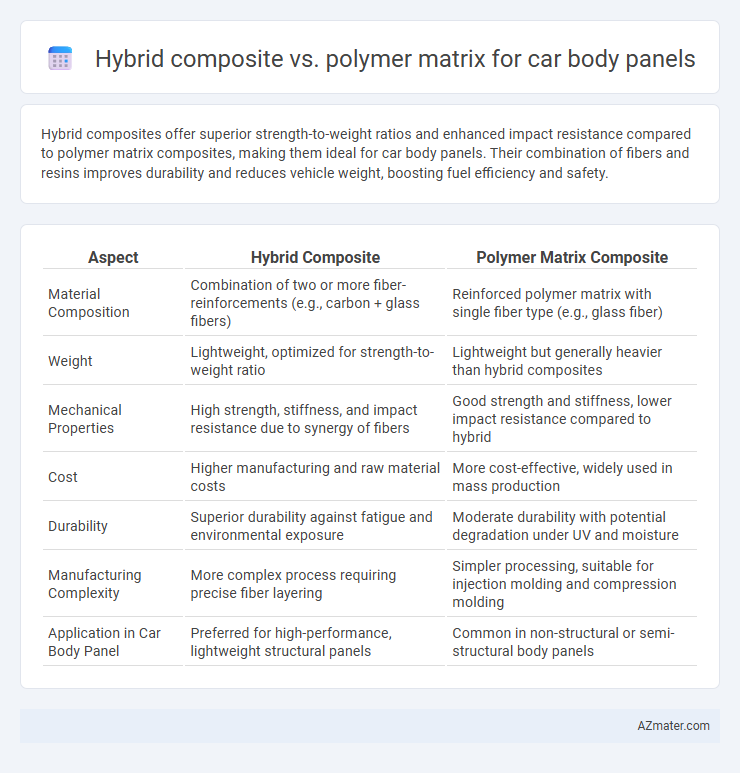Hybrid composites offer superior strength-to-weight ratios and enhanced impact resistance compared to polymer matrix composites, making them ideal for car body panels. Their combination of fibers and resins improves durability and reduces vehicle weight, boosting fuel efficiency and safety.
Table of Comparison
| Aspect | Hybrid Composite | Polymer Matrix Composite |
|---|---|---|
| Material Composition | Combination of two or more fiber-reinforcements (e.g., carbon + glass fibers) | Reinforced polymer matrix with single fiber type (e.g., glass fiber) |
| Weight | Lightweight, optimized for strength-to-weight ratio | Lightweight but generally heavier than hybrid composites |
| Mechanical Properties | High strength, stiffness, and impact resistance due to synergy of fibers | Good strength and stiffness, lower impact resistance compared to hybrid |
| Cost | Higher manufacturing and raw material costs | More cost-effective, widely used in mass production |
| Durability | Superior durability against fatigue and environmental exposure | Moderate durability with potential degradation under UV and moisture |
| Manufacturing Complexity | More complex process requiring precise fiber layering | Simpler processing, suitable for injection molding and compression molding |
| Application in Car Body Panel | Preferred for high-performance, lightweight structural panels | Common in non-structural or semi-structural body panels |
Introduction to Car Body Panel Materials
Car body panels require materials that combine lightweight properties with durability and impact resistance. Hybrid composites offer enhanced mechanical strength and stiffness by integrating fibers such as carbon or glass with polymer matrices, improving performance over conventional polymer matrix composites alone. Polymer matrix composites provide corrosion resistance and ease of molding, but hybrid composites are increasingly favored in automotive applications for optimizing weight reduction and structural integrity.
Overview of Hybrid Composite Materials
Hybrid composite materials for car body panels combine two or more reinforcement fibers with a polymer matrix to optimize strength, stiffness, and impact resistance. These materials offer superior mechanical properties and enhanced damage tolerance compared to traditional polymer matrix composites, making them ideal for lightweight automotive applications. The synergy between different fibers, such as carbon and glass, within the polymer matrix significantly improves durability and energy absorption during collisions.
Characteristics of Polymer Matrix Composites
Polymer matrix composites (PMCs) for car body panels exhibit high strength-to-weight ratios, corrosion resistance, and excellent impact absorption. Their thermoset or thermoplastic matrices provide design flexibility, enabling complex shapes and reduced manufacturing costs compared to hybrid composites. PMCs also offer superior thermal insulation and fatigue resistance, critical for automotive durability and performance.
Mechanical Performance Comparison
Hybrid composite car body panels exhibit superior mechanical performance over traditional polymer matrix composites, offering enhanced tensile strength, impact resistance, and stiffness. The integration of multiple fiber types, such as carbon and glass fibers, in a hybrid composite matrix results in improved load distribution and energy absorption during collisions. This combination leads to increased durability and weight reduction, making hybrid composites ideal for automotive structural applications requiring high mechanical reliability.
Weight Reduction and Efficiency
Hybrid composite car body panels offer superior weight reduction compared to traditional polymer matrix composites by integrating materials such as carbon fiber and glass fiber, enhancing strength-to-weight ratio significantly. This optimized material structure improves fuel efficiency and vehicle performance by reducing overall mass without compromising impact resistance or durability. Polymer matrix composites, while lightweight and corrosion-resistant, generally lack the tailored mechanical properties of hybrid composites, making hybrids the preferred choice for advanced automotive applications focused on efficiency.
Impact Resistance and Crash Safety
Hybrid composite materials for car body panels exhibit superior impact resistance and crash safety compared to traditional polymer matrix composites due to their combined fiber reinforcements, such as carbon and glass fibers, which enhance energy absorption and reduce damage under collision forces. Polymer matrix composites, while lightweight and corrosion-resistant, generally show lower impact resistance and may experience more extensive post-impact deformation, compromising crash safety. The increased stiffness and toughness of hybrid composites contribute to improved vehicle structural integrity and occupant protection during crashes.
Manufacturing Processes and Scalability
Hybrid composites for car body panels combine multiple fibers such as carbon and glass within a polymer matrix, enhancing mechanical properties while allowing versatile manufacturing processes like resin transfer molding and automated fiber placement. Polymer matrix composites (PMCs) primarily use thermoset or thermoplastic resins, enabling large-scale production through methods such as compression molding and injection molding with shorter cycle times. Scalability favors PMCs due to their simplified processing and material availability, whereas hybrid composites offer superior performance but often require more complex, cost-intensive fabrication techniques.
Environmental Impact and Sustainability
Hybrid composites in car body panels offer enhanced environmental benefits by combining natural fibers with synthetic polymers, reducing reliance on non-renewable resources and lowering carbon emissions during production. Polymer matrix composites, often derived from petroleum-based resins, typically generate higher environmental footprints due to energy-intensive manufacturing and end-of-life disposal challenges. The increased recyclability and biodegradability potential of hybrid composites contribute to improved sustainability in automotive applications compared to conventional polymer matrix materials.
Cost Analysis and Economic Considerations
Hybrid composites offer a cost advantage over polymer matrix composites in car body panels due to their superior mechanical properties and reduced material usage, leading to lower manufacturing and maintenance expenses. The integration of fiber reinforcements within polymer matrices enhances strength-to-weight ratios, resulting in improved fuel efficiency and long-term economic benefits. Life cycle cost analysis reveals that hybrid composites provide a more cost-effective solution by minimizing repair costs and extending the service life of automotive components.
Future Trends in Automotive Body Panel Materials
Hybrid composite materials for car body panels offer superior strength-to-weight ratios and enhanced impact resistance compared to traditional polymer matrix composites, driving future trends in automotive lightweighting and fuel efficiency. Advances in nanotechnology and bio-based resins are expected to enhance the mechanical properties and sustainability of polymer matrix composites, making them more competitive for large-scale automotive applications. Integration of smart sensing technologies within hybrid composites will enable real-time structural health monitoring, aligning with the industry's shift toward connected and autonomous vehicles.

Infographic: Hybrid composite vs Polymer matrix for Car body panel
 azmater.com
azmater.com